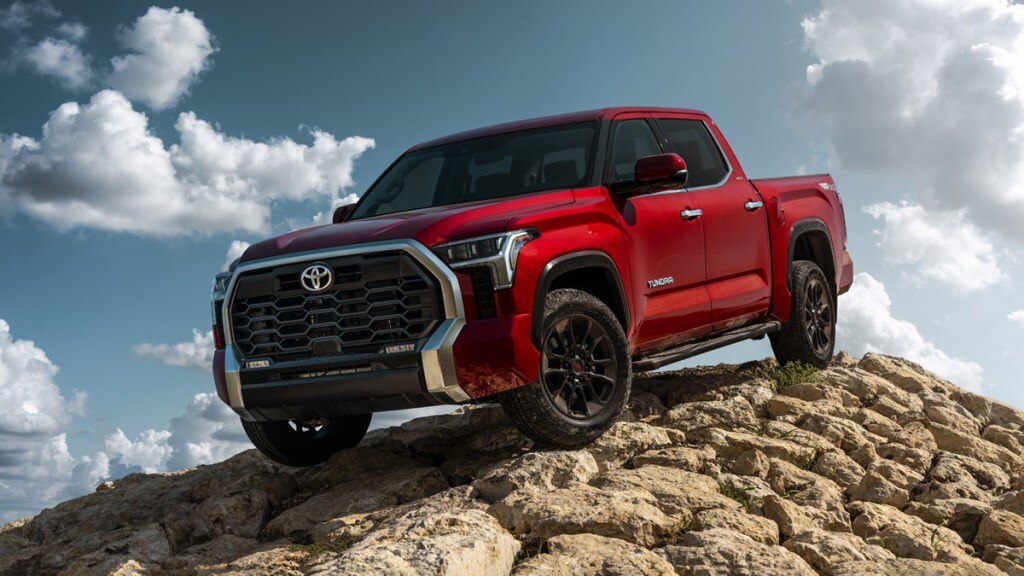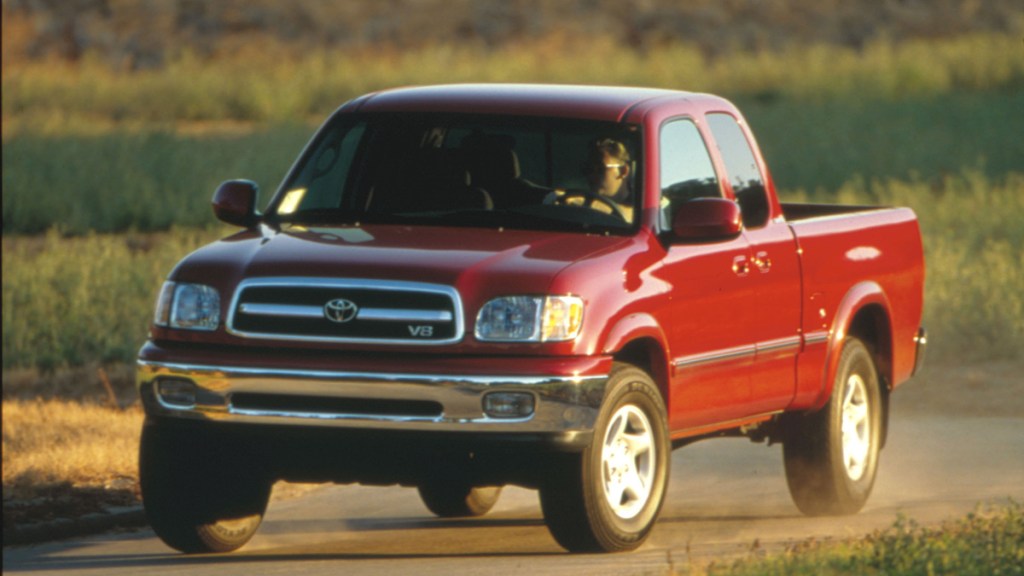Used Toyota Tundra Quick Facts
- The best years to buy a used Toyota Tundra truck fall between 2014 and 2021.
- The third-generation Tundra offers a hybrid engine option.
- The Tundra only comes in a 1/2-ton configuration.
Buying a used full-size pickup truck like the Toyota Tundra carries its share of risk. Trucks get worked hard and exposed to dents, high mileage, heavy workloads, and rust. For these reasons, choosing a truck with a reputation for durability, longevity, and high resale only makes sense when buying used. That’s where the Toyota Tundra comes in. Although only available in a 1/2-ton configuration, the Toyota Tundra is a solid machine with an exceptionally strong reputation. It may not have as many configurations or powertrain options as its rivals from Ford, Chevrolet, and Ram (formerly Dodge), but the Toyota Tundra models that fit your needs make a great used buy.
- Which Is the Best Model-Year Used Toyota Tundra?
- Toyota Tundra By Generation: Which Should You Buy?
- Which Toyota Tundra is Right for You
- Should You Buy a Used Toyota Tundra?
- Are Toyota Tundra Trucks Reliable?
- Used Toyota Tundra Model Years to Avoid
- Can You Take a Toyota Tundra Off-Roading?
- How Much Can a Toyota Tundra Tow?
Which Is the Best Model-Year Used Toyota Tundra?
The best years to buy a used Toyota Tundra fall between 2014 and 2021. These years have a series of proven V8 engines and more modern interiors than the older models. Those seeking advanced driver assist systems like forward collision warning and adaptive cruise control will want a 2018 or newer model.
While the newest Tundra has a lot going for it, right out the door, it suffered a few problematic glitches that have us suggesting it might not be the best-used Tundra choice. The most serious involved a recall affecting 2022-2023 for a manufacturing defect that could cause the engine to lose power or seize up. This issue and the truck’s relatively short production run make predicting long-term reliability and resale difficult. For traditionalists, the second-generation Tundra offers the features most coveted by the pickup truck class, namely a V8 engine and a long history of proven reliability. But, even within this generation, there are years to covet and others to avoid.
We should point out that early Tundra models suffered from rust issues, specifically around the frame. Toyota addressed some of the worst examples with a recall, but as the frame remains the same throughout this generation, there’s no saying the same fate won’t befall newer trucks down the road. If you’re buying used Tundra from an area that regularly uses road salt in the winter months, be sure to have the underside thoroughly inspected. If the frame is in reasonable condition, you’ll want to have it undercoated every few years and keep it clean between treatments. Other areas of concern involve cam tower leaks on the 5.7-liter V8, rusted lower control arms, and poor fuel economy. Besides that, the Tundra has a solid history, with many owners reporting mileage of more than 200,000 with no significant issues beyond normal wear and tear.
Before buying any used truck, obtain a vehicle history report to see how it was maintained and if it experienced any accidents.
See Toyota Tundra trucks for sale near you.
Toyota Tundra By Generation: Which Should You Buy?
Third Generation: 2022-Current

The third-generation Tundra loses the previous generation’s V8 engine in favor of two new turbocharged V6s. The standard engine is an i-Force twin-turbocharged V6, producing 389 horsepower and 479 lb-ft of torque. The second is a hybrid powertrain called the i-Force Max. It combines the same twin-turbocharged V6 with an electric motor for a total output of 437 hp and 583 lb-ft of torque. Both engines pair to a 10-speed automatic transmission. Although this engine provides more horsepower and torque than the old V8 it replaces, some early defects in the manufacturing process forced a substantial recall on all 2022-2023 Tundra trucks.
Other new features include a rear coil spring suspension, an available air suspension, and a stiffer boxed frame. The third-gen Tundra arrives in Double Cab and CrewMax configurations, with 5.5- and 6.5-foot beds on the CrewMax and 6.5- and 8.1-foot beds on the Double Cab.
Trims range from the essential SR and SR5 to the luxurious Limited, Platinum, 1794 Edition, and Capstone. There’s also an off-road-ready TRD Pro and numerous off-road option packages. Some of the Tundra’s more notable features include a large infotainment touchscreen (up to 14 inches), a 360-degree monitor, trailer hitch guidance, a digital instrument cluster, and a blind-spot monitor that covers a trailer in tow. Upper trims can be fitted with a panoramic moonroof, leather upholstery, an adaptive suspension, a 12-speaker JBL audio system, and a power tilt/telescopic steering wheel.
The Toyota Safety Sense 2.5 suite adds forward collision warning, adaptive cruise control, lane-keeping assist, automatic high-beam headlights, and road sign alerts.
Model-Year Changes:
2024: Changes are limited to some upgraded packages, like the TRD Off-Road package offered on the Platinum trim.
2023: The SR5 gets a new blackout package.
See 2022-to-current Toyota Tundra trucks for sale near you
Second Generation: 2007-2021

The second-generation Tundra is one of the most sought-after trucks on the market, and we understand why. This truck has an unusually long run, spanning 14 years, with only one major upgrade. Compared to the first-generation Tundra, this model expands the number of trims, bed lengths, and cab configurations. In the early years, engine choices include a V6 and two V8s. We suspect you won’t find many V6 models, but the V8s, as well as models with 4-wheel drive (4WD), are plentiful. However, the Tundra doesn’t offer the advanced off-road features of some competitors, like front lockers. Towing for the second generation increases to 10,000 pounds, and the payload number maxes at around 1,730 pounds. The second-generation Tundra also offers more technology, better audio systems, and, on later models, important driver-aids like forward collision warning, automatic high-beam headlights, adaptive cruise control, and a blind-spot monitor.
Model-Year Changes:
2021: Some paint color changes and two limited-edition models mark the final year for the second-gen Tundra.
2020: The 4.6-liter V8 is no more, but new features include an 8-inch touchscreen, standard Apple CarPlay/Android Auto, and Smart Key with push-button start.
2019: The TRD Pro rejoins the lineup, featuring Fox shocks and BBS alloy wheels.
2018: Toyota Safety Sense-P is made standard. The Regular Cab and TRD Pro get dropped.
2017: No significant changes.
2016: Limited, Platinum, TRD Pro, and 1794 models get a larger 38-gallon fuel tank. Trucks with the 5.7-liter V8 gain trailer brake control.
2015: The V6 is dropped, making the 4.6-liter V8 the new standard engine.
2014: A major refresh brings a new interior and exterior, plus the first 1794 Edition.
2013: Toyota’s Entune audio system enters the Tundra cab.
2012: Limited and TRD trims gain a standard rear backup camera.
2011: The V6 gains 34 hp, increasing to 270 total. Trailer sway control is made standard.
2010: The 4.6-liter V8 joins the lineup, and new standard equipment includes a driver’s knee airbag, height-adjustable headlamps, and two new audio options.
2009: The Tundra adds two new TRD packages.
2008: Toyota offers a supercharger kit for the 5.7-liter V8.
See 2008-2021 Toyota Tundra trucks for sale near you
First Generation: 2000-2006

With the first-generation Tundra, Toyota was just dipping its toe into the full-size pickup truck pool. The first Tundra configurations came in Regular Cab and Access Cab, with Double Cab joining later in the model run. Power choices included a V6 or V8 engine, and a manual transmission was standard on the base V6 models. The V8 later offered a supercharger for more power. Towing maxes out at 7,000 pounds.
2006: No major changes.
2005: A new 4.0-liter V6 is added, while the 4.7-liter V8 gains more power.
2004: A new Double Cab (crew cab) joins the lineup.
2003: Antilock brakes are standard, and the entire line gets a slight exterior makeover.
2002: V8 trucks offer a limited-slip differential.
2001: Access Cab models with a V8 offer the TRD Off-Road package.
See 2000-2006 Toyota Tundra trucks for sale near you
Which Toyota Tundra is Right for You?
For those needing a basic work truck to do light hauling, the SR and SR5 are the best choices. The V6 models are not terribly powerful but are the best on gas. The sweet spot for those not needing maximum towing and payload are trucks with the 4.6-liter V8. If you’re looking for something to go off-roading, the TRD trims are best, while luxury buyers looking for the most cab space and high-tech features should look to the Limited, Platinum, and 1794 Editions, all of which will likely have the most powerful V8 engine.
Should You Buy a Used Toyota Tundra?
A used Toyota Tundra is a wise choice, especially a late-model second-generation truck. The Tundra has an excellent reputation for durability and longevity, so long as owners attend to the few issues mentioned in the intro. The Tundra also holds exceptional resale value. Check our sister site, Kelley Blue Book, to research the value of the used Tundra you want to buy.
Are Toyota Tundra Trucks Reliable?
The Tundra is a very reliable truck, with only a few known issues that might arise. Its engine, transmission, electronics, and suspension all earn high marks for longevity and ease of repair.
Used Toyota Tundra Model Years to Avoid
The first-generation trucks are probably few and far between, with rust being one of the underlying causes. Of the second generation, we’d steer clear of the earlier models (2007-2013) due to ongoing rust issues. They’ll also likely have mileage over 200,000, at which point even the best-engineered parts can start to wear out.
Can You Take a Toyota Tundra Off-Roading?
The Tundra is a rugged truck; even the most basic trim can venture off-road successfully. However, if you plan on taking your truck over unforgiving terrain, a TRD trim or one equipped with a TRD package is the best choice.
How Much Can a Toyota Tundra Tow?
The first-generation Tundra can tow a maximum of 7,000 pounds, the second-generation can pull 10,000, and the third-generation can tow up to 12,000 pounds.
See used Toyota Tundra trucks for sale near you
RELATED: Payload vs. Towing Capacity: Why It’s Important to Know the Difference











